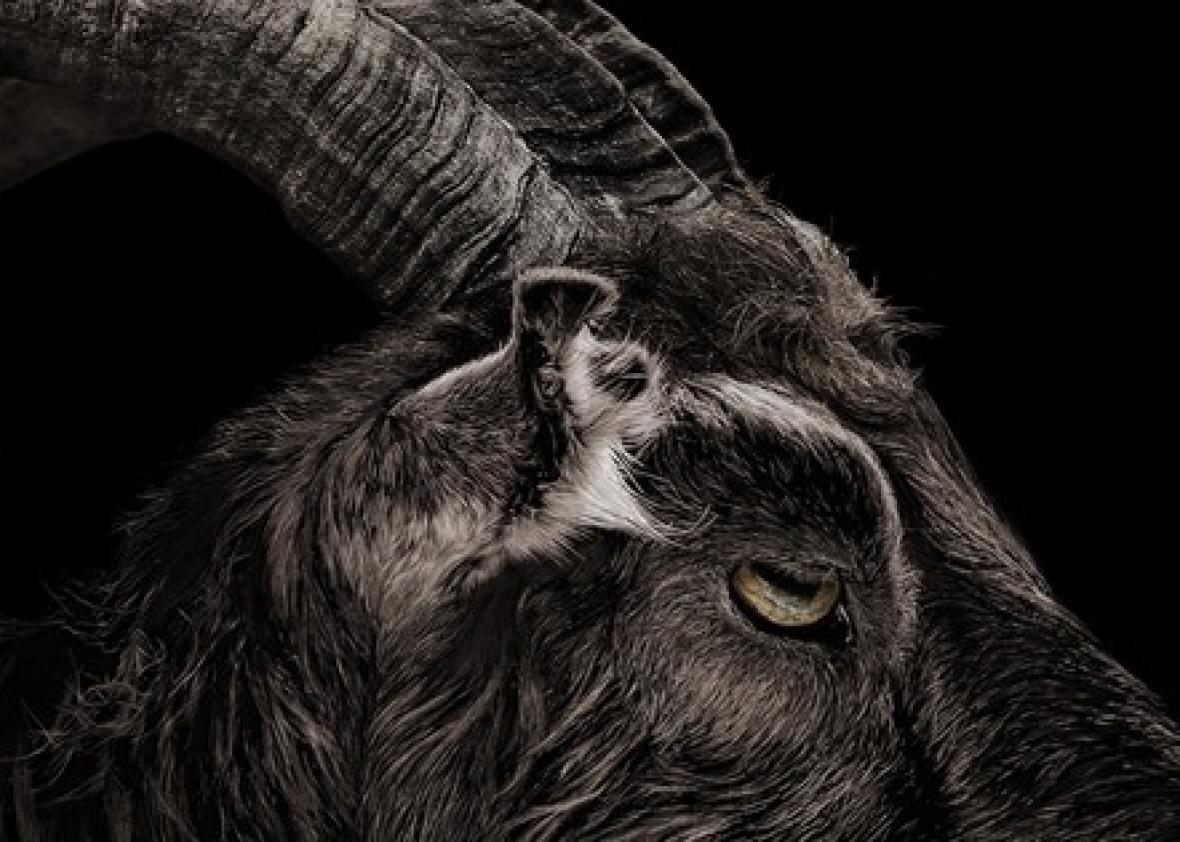Witchy spoilers ahead.
If goats have recently enjoyed an Internet-aided renaissance thanks to their uncanny ability to yell like humans, The Witch reminds us of the beasts’ Satanic true nature. Black Phillip, the goat who may be tormenting a family in 17th century New England, became an instant star after the film’s debut at Sundance, spooking up early trailers and earning his own Twitter account months before the movie’s release. For a while, it isn’t clear if Black Phillip is an unlucky creature born to a family of hysterics, an instrument of a witch deep in the woods, or perhaps even the devil incarnate. By the movie’s delicious final moments, there is very little doubt at all.
What about the traditions that inspired Black Phillip himself? Writer-director Robert Eggers closes The Witch by noting on screen that much of the film came “directly from period journals, diaries, and court records,” and his movie goes to extraordinary lengths to summon authentic 17th century wares and atmosphere. So are there actual accounts of insidious goats terrorizing North American settlers? Why are goats linked to the occult, anyway? Is Black Phillip real??
The answer to the first two questions, alas, is no. “I’m sorry to disappoint you, but there is nothing about goats in the Salem records or, that I can recall, in any American records of other witchcraft prosecutions,” the famous Cornell scholar Mary Beth Norton wrote to me. She hadn’t seen The Witch yet, but she said “there has been a considerable amount of email talk about this movie among certain Salem scholars.”
Emerson Baker, a history professor at Salem State University, co-hosted a packed screening of The Witch in Salem, and considers himself among the film’s biggest fans—“It’s just about the best depiction of early New England that I’ve seen in a movie,” he told me. But he too said he didn’t recall goats in North American lore or historical records. Still, he praised the movie’s depiction of “animal familiars,” or creatures believed to be in the thrall of witches. “There aren’t a lot of direct goat antecedents, but pretty much any animal could be a witch’s familiar—that’s certainly an accurate notion,” he said. “One of the definitions of a witch is of a shapeshifter, and the ability to put themselves into animal form. We see that repeatedly, in the concept of the black cats, or rats, mice, dogs, you name it.” He noted a record of two dogs in Salem, in 1692, who were shot to death because they were believed to be witches. Baker had particular praise for The Witch’s evil rabbit and evil raven, but he enjoyed Black Phillip, too (“I follow him on Twitter”).

A24
Eggers, the movie’s writer and director, conceded that Black Phillip is in some ways his own special creation. “It’s not that I’ve not found any evidence in English witchcraft of goats playing some kind of function similar to this, but it’s just not as common,” he said. “Most of the goat mythology tends to be from continental witchcraft. In England, goat farming was not something you would really want to do. If you were a goat farmer, you were thought of as very backward.”
“I think some hardcore witch historians might be offended by my use of some of these continental tropes,” he added, laughing. “All my talk about accuracy, they might think, Well, uh uh uh.” Still, Eggers defended Black Phillip’s depiction, pointing to artwork showing witches riding goats instead of sticks, along with engravings and woodcuts depicting goats. He also cited Goya, with paintings like “Witches’ Sabbath (The Great He-Goat).”
I followed the history a bit more to England, where Eggers and several American scholars also pointed me. Malcolm Gaskill, a professor of early modern history at the University of East Anglia, confirmed that goats play a more prominent role in European witch imagery. “In European engravings and painting[s] that depict the witches’ sabbath—that is, the remote meetings where witches were supposed to gather to pay homage to Satan—the devil is often depicted as a goat or a goat-like man,” he wrote. Still, contra The Witch, he said that in actual witchcraft trials, animals that were said to physically represent the devil tended to be smaller creatures like cats, mice, dogs, and birds.
Anyone who has seen The Witch can agree that these slight elisions of witchcraft history have a major upside for the movie, and at least this viewer is pleased that Eggers allowed himself a little genre latitude to create Black Phillip. (Other important Phillip facts: He’s played by a lone goat, real name Charlie; Charlie is a huge jerk and was very difficult on set; he was voiced by the male model Wahab Chaudhry.) But what of the larger question behind these depictions—when did goats first become a tool of the occult? Everyone I asked pointed in different directions, including Greek mythology (think Pan), biblical references, Baphomet, and a rich artistic record stretching back to the Middle Ages. There is no single point of reference, but goats pervade many strands of mythology connected to malevolent spirits, and Eggers isn’t even the first contemporary horror director to seize on the association. Sam Raimi, in 2009’s Drag Me to Hell, transferred a demon into a goat during an uproarious séance, which then turned to Alison Lohman’s doe-eyed protagonist and yelled, in perfect goat tongue, “You black-hearted whor-or-ore! You bi-i-ii-tch!”
The origins may be elusive, but Gaskill, the English historian, offered a convincing explanation for why the link exists. “I guess the goat-devil features so prominently in European iconography because of the horns and weird eyes,” he wrote, “but also because of the association with predatory sexual potency and energy.” With its lingering camera on Black Phillip’s dead stare, and its terror at a pubescent girl’s “transformation,” The Witch may ultimately be a potent distillation of why goats feature into this kind of narrative in the first place.
